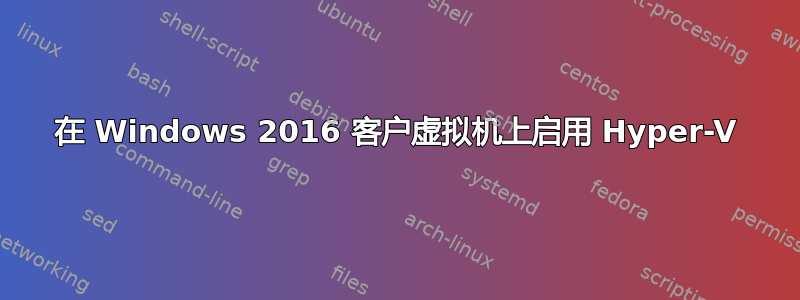
我在虚拟机中安装了 Windows 2016,我想在其中使用 Hyper-V。主机是 XUbuntu。但是,每次我尝试启用它时,系统都会提示我未在 BIOS 中启用虚拟化。事实上,在使用英特尔处理器识别实用程序时,系统会提示我虽然虚拟化处理器可以处理虚拟化,但 VT-D 未启用。
对于虚拟机,我使用 UEFI 作为 BIOS 类型。我开始认为这就是整个问题所在。因为当我进入菜单时,没有一个与虚拟化相关的单一选项。
以下是 Windows 客户机的 XML:
<domain type='kvm'>
<name>Gaming_Server</name>
<uuid>ef50c993-194f-4090-9e07-917402fd5ae9</uuid>
<memory unit='KiB'>10485760</memory>
<currentMemory unit='KiB'>10485760</currentMemory>
<vcpu placement='static'>10</vcpu>
<os>
<type arch='x86_64' machine='pc-q35-2.5'>hvm</type>
<loader readonly='yes' type='pflash'>/usr/share/OVMF/OVMF_CODE.fd</loader>
<nvram>/var/lib/libvirt/qemu/nvram/Gaming_Server_VARS.fd</nvram>
<boot dev='hd'/>
<bootmenu enable='yes'/>
</os>
<features>
<acpi/>
<apic/>
<hyperv>
<relaxed state='on'/>
<vapic state='on'/>
<spinlocks state='on' retries='8191'/>
</hyperv>
</features>
<cpu mode='host-model'>
<model fallback='allow'/>
<topology sockets='1' cores='5' threads='2'/>
</cpu>
<clock offset='localtime'>
<timer name='rtc' tickpolicy='catchup'/>
<timer name='pit' tickpolicy='delay'/>
<timer name='hpet' present='no'/>
<timer name='hypervclock' present='yes'/>
</clock>
<on_poweroff>destroy</on_poweroff>
<on_reboot>restart</on_reboot>
<on_crash>restart</on_crash>
<pm>
<suspend-to-mem enabled='no'/>
<suspend-to-disk enabled='no'/>
</pm>
<devices>
<emulator>/usr/bin/kvm-spice</emulator>
<disk type='file' device='disk'>
<driver name='qemu' type='qcow2'/>
<source file='xxxx/Windows_Gaming_Server.qcow2'/>
<target dev='vda' bus='virtio'/>
<address type='pci' domain='0x0000' bus='0x02' slot='0x05' function='0x0'/>
</disk>
<disk type='file' device='disk'>
<driver name='qemu' type='raw' cache='writeback'/>
<source file='xxxx/Games.img'/>
<target dev='vdb' bus='virtio'/>
<address type='pci' domain='0x0000' bus='0x02' slot='0x06' function='0x0'/>
</disk>
<disk type='file' device='cdrom'>
<driver name='qemu' type='raw'/>
<target dev='sda' bus='sata'/>
<readonly/>
<address type='drive' controller='0' bus='0' target='0' unit='0'/>
</disk>
<disk type='file' device='cdrom'>
<driver name='qemu' type='raw'/>
<source file='xxxx/virtio-win-0.1.126.iso'/>
<target dev='sdb' bus='sata'/>
<readonly/>
<address type='drive' controller='0' bus='0' target='0' unit='1'/>
</disk>
<controller type='usb' index='0' model='nec-xhci'>
<address type='pci' domain='0x0000' bus='0x02' slot='0x03' function='0x0'/>
</controller>
<controller type='sata' index='0'>
<address type='pci' domain='0x0000' bus='0x00' slot='0x1f' function='0x2'/>
</controller>
<controller type='pci' index='0' model='pcie-root'/>
<controller type='pci' index='1' model='dmi-to-pci-bridge'>
<model name='i82801b11-bridge'/>
<address type='pci' domain='0x0000' bus='0x00' slot='0x1e' function='0x0'/>
</controller>
<controller type='pci' index='2' model='pci-bridge'>
<model name='pci-bridge'/>
<target chassisNr='2'/>
<address type='pci' domain='0x0000' bus='0x01' slot='0x01' function='0x0'/>
</controller>
<controller type='virtio-serial' index='0'>
<address type='pci' domain='0x0000' bus='0x02' slot='0x04' function='0x0'/>
</controller>
<interface type='direct'>
<mac address='52:54:00:ed:2a:69'/>
<source dev='eno1' mode='bridge'/>
<model type='rtl8139'/>
<address type='pci' domain='0x0000' bus='0x02' slot='0x01' function='0x0'/>
</interface>
<serial type='pty'>
<target port='0'/>
</serial>
<console type='pty'>
<target type='serial' port='0'/>
</console>
<channel type='spicevmc'>
<target type='virtio' name='com.redhat.spice.0'/>
<address type='virtio-serial' controller='0' bus='0' port='1'/>
</channel>
<input type='tablet' bus='usb'/>
<input type='mouse' bus='ps2'/>
<input type='keyboard' bus='ps2'/>
<graphics type='spice' autoport='yes'>
<image compression='off'/>
</graphics>
<sound model='ich6'>
<address type='pci' domain='0x0000' bus='0x02' slot='0x02' function='0x0'/>
</sound>
<video>
<model type='qxl' ram='65536' vram='65536' vgamem='16384' heads='1'/>
<address type='pci' domain='0x0000' bus='0x00' slot='0x01' function='0x0'/>
</video>
<hostdev mode='subsystem' type='pci' managed='yes'>
<source>
<address domain='0x0000' bus='0x03' slot='0x00' function='0x0'/>
</source>
<address type='pci' domain='0x0000' bus='0x02' slot='0x07' function='0x0'/>
</hostdev>
<hostdev mode='subsystem' type='pci' managed='yes'>
<source>
<address domain='0x0000' bus='0x03' slot='0x00' function='0x1'/>
</source>
<address type='pci' domain='0x0000' bus='0x02' slot='0x08' function='0x0'/>
</hostdev>
<redirdev bus='usb' type='spicevmc'>
</redirdev>
<redirdev bus='usb' type='spicevmc'>
</redirdev>
<memballoon model='virtio'>
<address type='pci' domain='0x0000' bus='0x02' slot='0x09' function='0x0'/>
</memballoon>
</devices>
</domain>
为了证明我已经嵌套虚拟化:
$ cat /sys/module/kvm_intel/parameters/nested
Y
所以我真的不知道问题是什么以及如何解决它......
答案1
为了在 Windows 中使用虚拟化选项,您需要使用最新的 QEMU 和 Libvirt 版本。此外,对于 UEFI,您还需要最新版本的 OVMF (Titanocore)。一旦您编译和/或安装了上述软件(根据需要),您就需要在该 VM 的 XML 配置文件中添加以下几行:
<features>
...
<hyperv>
...
<vendor_id state='on' value='something'/>
</hyperv>
<kvm>
<hidden state='on'/>
</kvm>
...
</features>
<cpu mode='host-passthrough' check='none'>
...
<feature policy='disable' name='hypervisor'/>
</cpu>
vendor_id现在,我对和值不太确定,kvm hidden state但对 值比较确定cpu hypervisor feature tag,但谨慎一点总比后悔好。这将确保:
- Windows 无法通过 CPU 得知自己处于虚拟机管理程序中
- Windows 将无法分辨它在 KVM 内。
- 如果它以某种方式设法弄明白它是在虚拟机管理程序中,它将不知道来自哪个程序或公司,并且我相信它会简单地假设它是在 Windows VM 中,而不是其他地方。
我对这个主题的技术知识相当有限,因此如果需要,请参阅相关文档并了解更多信息。
答案2
尝试将 CPU 模式更改为“host-passthrough”。它应该可以工作,但担心您会遇到其他错误,例如“Microsoft Hyper-V 虚拟机总线提供程序”错误。


